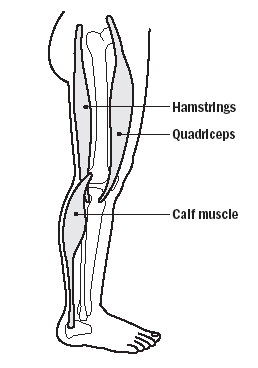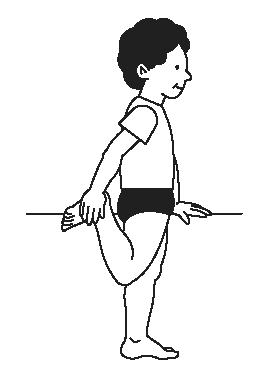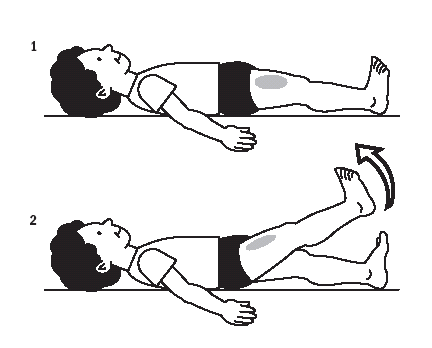In the weeks before surgery, your child
will commence physiotherapy. This will consist of a training
programme to stretch and strengthen particular muscles. Fitness is
also important and activities such as swimming and bike riding are
recommended. Figure 1

Figure 1
The fixator may be in place for many
weeks. During this time exercise and movement are essential to keep
bones and muscles fit and strong. The orthopaedic surgeon will tell
you when your child should start walking again after surgery. This
is normally within the first weeks, since walking is helpful for
the formation of new bone as well as maintenance of bone density.
Figure 2

Figure 2
In limb reconstruction above the knee,
certain muscles will particularly require stretching. These muscles
are:
1. The hamstrings: the muscle at the
back of the thigh which bends the knee.
2. The quadriceps: the large muscle at
the front of the thigh which straightens the knee.
3. The calf muscle: the muscle at the
back of the lower leg. Figure 3

Figure 3
Surgery lengthens or re-aligns the
bone, but does not lengthen the muscles which attach to it. These
muscles may therefore feel tighter after surgery. To prevent
serious muscle tightness, we need to:
1. Position the leg correctly in bed so
that the knee is straight. Figure 4

Figure 4
2. Exercise to regularly stretch the
hip, knee and ankle muscles.
The physiotherapist will visit your
child in hospital and teach correct positioning and appropriate
exercise.
Before surgery, some simple exercises
to stretch and strengthen will also be most helpful.
Exercises before surgery
To stretch hamstrings
Tuck right/left heel near groin with
the opposite leg straight. Reach down until a stretch is felt in
the back of the thigh. Hold for 30 seconds x 2. Figure 5

Figure 5
OR
Long Sitting: The young child may long
sit for 5 - 10 minutes or as tolerated (keep knees and back
straight). Figure 6
Figure 6
To stretch quadriceps
Pull right/left heel towards
buttock until a stretch is felt in the front of thigh. Hold 30
seconds x 2. Figure 7

Figure 7
OR
Lie on tummy (hips flat). While keeping
hips flat, bend knee until a stretch is felt in front of thigh.
Assist as necessary. Hold 30 seconds x 2. Figure 8
To stretch calf muscle
Standing stretch: Keep the back knee
straight with the heel on the floor and the toes pointing forward.
Lean into the wall until a stretch is felt in the calf. Hold for 30
seconds x 2. Figure 9

Figure 9
OR
Towel Stretch: With the knee straight,
use a towel to gently pull the foot towards face until a stretch is
felt in calf. Hold for 30 seconds x 2. Figure 10

Figure 10
OR
Assisted stretch for young child: With
knee straight, gently pull foot towards face. The child should feel
a comfortable stretch in the calf. Hold for 30
seconds x 2. Figure 11

Figure 11
OR
To strengthen hip and knee.
Straight leg raise. Tighten muscle on
front of thigh, then lift leg from the floor keeping knee straight
x 10. Figure 12

Figure 12